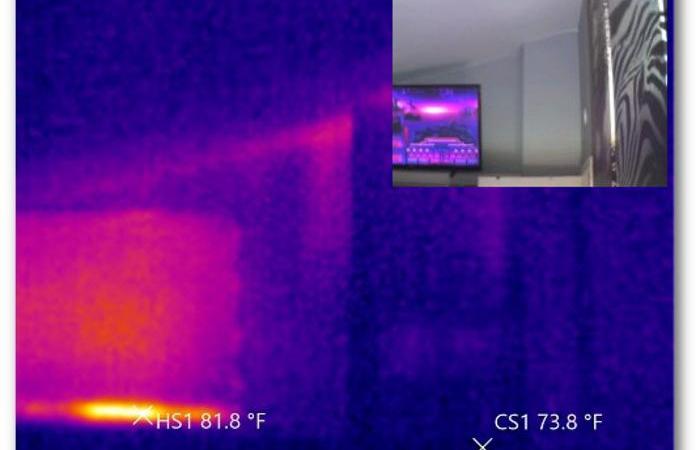C
Capillary Action movement of liquid within a material against gravity as a result of surface tension
Carbon Monoxide a dangerous byproduct of incomplete combustion; abbreviated as CO
Cathedral Ceiling a sloped ceiling with a pitch identical to the roof (no attic)
CAZ Combustion Appliance Zone; area from which combustion air, dilution air, and exhaust air is drawn Cellulose insulation made from shredded recycled newspaper with added fire and mold retardants
CFC chlorofluorocarbon; once used widely as a refrigerant, now banned
CFL compact fluorescent lamp; a lighting type more efficient than incandescent bulbs
CFM Cubic Feet per Minute; measure of airflow rate
Combustion burning fossil fuels to produce heat, CO2, and H2O vapor
Condensation vapor becoming a liquid when in contact with a surface at or below the dew point temperature
Conditioned Space area of the house serviced by the HVAC system
Conduction transmission of energy through a material or from one material to another by molecular contact
Convection transmission of energy to another location by movement of a fluid
Convective Loop continuous movement of heated or cooled fluids in an enclosed space
Crawlspace a foundation type with an enclosed unconditioned area between the ground and the house
D
Damper the portion of a forced air supply register that controls the amount of air delivery
Dense Packing filling cavities with loose fill insulation at a high density to achieve an air retarding effect
Density ratio of weight to volume for a given substance
Depressurization removal of air from a building by mechanical means
Dew Point temperature at which a given concentration of vapor begins to condense into a liquid
Diffuser the portion of a forced air register that controls airflow direction Diffusion equalization of vapor concentration within a confined space or across a permeable membrane
DOE U.S. Department of Energy
Draft negative pressure in a flue caused by buoyancy of exhaust gases from combustion appliances
E
ECM Energy Conservation Measure
EER Energy Efficiency Ratio; central or window air conditioning efficiency measured at steady state
EERE DOE Office of Energy Efficiency and Renewable Energy
Emissivity relative ability of a surface to absorb radiant energy and re-radiate it to other matter
Energy Model prediction of a buildings utility consumption; usually software based
Energy Star® DOE/EPA label for appliances and housing indicating 20% less than standard energy usage
EPA U.S. Environmental Protection Agency
ERV mechanical ventilation system that transfers heat and humidity from stale exhaust air to fresh intake air
Evaporation the absorption of a liquid into surrounding air via vaporization Exfiltration uncontrolled leakage of air from inside the home to the outside through cracks in
building materials
F
Fenestration window and door openings in the building envelope
Fiberglass insulation made from recycled glass bottles in loose fill, batt, and blanket forms
Flame Spread standard test for determining the ignition point of a building material
Flash Point minimum temperature at which a vaporizing building material will exhibit flammability
Fluid Transport movement of gases and liquids into, out of, or within a building
Foamboard insulation in rigid sheets (usually 4’ X 8’) sold as polystyrene or polyisocyanurate
Forced Air type of HVAC system that uses a fan to distribute hot or cold air through ducts
G
Geothermal type of HVAC system that facilitates heat transfer between the house and the earth’s crust
H
Heat Gain radiant heat produced internally in a building by occupants, mechanicals, lighting, and appliances
Heat Loss heat moving out of a building due to conduction through the thermal boundary
Heat Rise difference in temperature between the return plenum and the supply plenum in a forced air system
Heat Transfer movement of heat energy into, out of, or within a building
HERS Home Energy Rating System; certification program for new homes administered by RESNET
HES Home Energy Score; rating system administered by DOE HPwES®
Home Performance with Energy Star®; certification program for existing homes administered by BPI
HRV mechanical ventilation system that recovers heat energy from exhaust air and transfers it to intake air
HCFC hydrochloroflourocarbon; replaced CFCs as a refrigerant in 1978
HSPF Heating Seasonal Performance Factor; measure of heat pump efficiency
Humidistat control device that actuates an HVAC system when interior relative humidity reaches a preset limit
HVAC Heating, Ventilation, & Air Conditioning
Hydronic type of HVAC system that uses water to distribute heat through pipes
Hydrophilicity ability of a substance to absorb bulk moisture; opposite of hydrophobicity
Hygrometer instrument that measures relative humidity of air
Hygroscopy ability of a substance to absorb humidity from the air without changing its density
I
IAQ Indoor Air Quality; measure of pollutants and contaminants present in conditioned air
IECC International Energy Conservation Code
Ignition Barrier material applied over foam insulation to control its volatility
Ignition Point minimum temperature at which a substance will burn without additional external heat Incandescent inefficient lighting type being phased out in most buildings
Induction Vent use of a small combustion chamber fan to increase the efficiency of an atmospheric vent Infiltration uncontrolled leakage of air into a building through material cracks and structural joints
Input hourly BTU consumption of an HVAC appliance Insulation any material with low thermal conductivity characteristics that is used to slow heat transfer Intrusion bulk moisture entering the building envelope
IRC International Residential Code Joist main framing member in a floor or ceiling structural system
K
Kilowatt-Hour standard unit for measuring electrical energy consumption; abbreviation kWh
Kinetic energy applied to matter that sets it in motion
L
Latent Heat heat released or absorbed by a substance when changing phases of matter (solid, liquid, gas)
LED Light Emitting Diode; type of lighting even more efficient than CFLs
LEED Leadership in Environmental Energy Design; certification program administered by USGBC
Low-E a coating on window glass that reduces emissivity
Luminous Efficacy the ratio of lighting intensity (lumens) to wattage consumption
M
Mean Radiant Temperature the average of all surface and air temperatures in a room
Mercury Column pressure exerted by the height of Hg in a tube 1 in² in cross-sectional area
MSDS standard format information sheet listing the handling precautions and physical properties of a product
Mold fungal growth resulting in deterioration of organic materials, especially under damp conditions
Moisture Boundary portion of the building envelope that controls bulk moisture transfer
O
OSHA Occupational Safety and Health Administration
Output hourly BTU production of an HVAC appliance
P
Pascal SI unit of pressure expressed as 1 kg of force per meter²
Payback number of years required for energy cost savings to equal the cost of installed ECMs
Perm defined as 1 grain of H2O vapor per ft² per hour per inch of Hg pressure differential through a substance
Percolation movement of bulk moisture downward through porous soil particles
Permeability rate of water vapor transmission through a substance regardless of its thickness
Permeance the permeability of a substance divided by its thickness
Pressure Boundary portion of the building envelope that controls convection of air and water vapor
Psychrometer a simple hygrometer made of two thermometers (dry bulb and wet bulb)
PSI standard unit of pressure expressed as pounds of force per inch²
PV photovoltaic; term used to describe electricity producing cells in a solar panel
R
Radiation heat transfer from a hot to cold object through an intermediate vacuum or gas-filled space
Radiant Heat Gain heat transfer through space from sunlight to a building
Rafter main framing member in a roof structural system
Refrigerant substance used in non-combustion HVAC systems that transfers latent heat via phase change
Register device on walls, floors, or ceilings that delivers supply air or gathers return air in a forced air system
Relative Humidity ratio of amount of moisture in air to maximum amount it can hold at a given temperature
R-Value unit of measurement of resistance to conductive heat transfer; reciprocal of U-Value
Reflectivity relative ability of a surface to resist absorption of radiant energy
RESNET Residential Services Energy Network; organization that evaluates new residential construction
Retrofit modification of an existing building or facility to include new systems or components
ROI Return on Investment; cost benefit metric calculated as the ratio of net energy savings to ECM installation
S
SEER measure of seasonal central AC energy efficiency; equal to the ratio of BTU output to KWH input
Sensible Heat heat released or absorbed by a substance as in response to a change in ambient temperature
Slab-on-Grade foundation type with a concrete first floor and no basement or crawlspace
SHGC Solar Heat Gain Coefficient; a measure of window energy efficiency
SIR Savings to Investment Ratio; cost metric calculated as the ratio of total energy savings to ECM installation
Sone a measure relative sound levels; usually applied to noise production of fan motors
SPF Spray Polyurethane Foam; either open cell (OC) or closed cell (CC) Spillage backdrafting of a combustion appliance into the CAZ SSE
Steady State Efficiency; the measured ratio of BTU output to BTU input of an appliance at a given time
Stack Effect pressure and density differences caused by building height that enhance air leakage rates
Standby electrical energy in appliances or heat energy in water heaters lost when not operating
Stud main framing member in a wall structural system
Sublimation direct transition from solids to gases bypassing the liquid state; also called off-gassing
Sustainability meeting current energy and resource needs without compromising future needs
T
Therm unit of energy equivalent to 105 BTU
Thermostat control that actuates an HVAC system when interior temperature reaches a preset limit
Thermal Barrier material applied over foam insulation to slow the degree of flame spread during a fire
Thermal Boundary portion of the building envelope that controls conductive and radiant heat transfer
Thermal Bridge an object of higher U-Value immediately adjacent to an object of lower heat transfer
Thermal Bypass a penetration in the pressure boundary that allows convective air loss
Thermography a diagnostic technique using an infrared camera to locate areas of temperature differential
U
UF U - Factor; a measure of window energy efficiency
UL Underwriters Laboratories; independent electrical appliance testing agency
USGBC US Green Building Council; organization that evaluates commercial construction
U-Value unit of conductive heat transfer through 1 ft² of a substance equal to 1 BTU per hour @ 1°F ΔT
V
Vapor Barrier moisture resistant material which controls moisture diffusion to < 0.1 perm
Vapor Retarder moisture resistant material which controls moisture diffusion to < 10 perm
Vaulted Ceiling a sloped ceiling with a pitch less than that of the roof
Ventilation mechanical supply or removal or air to/from rooms or the entire house
Viscosity property of a liquid that measures thickness or flow resistance
VOC Volatile Organic Compound; generally toxic chemicals that have a high degree of volatility
Volatility the tendency of a substance to vaporize or sublimate
Volt a measure of electrical force potential
VT Visible Transmittance; the amount of light that passes through window glass
W
WAP Weatherization Assistance Program; administered by DOE to assist low-income property owners
Water Column pressure exerted by the height of H2O in a tube 1 in² in cross-sectional area
Watt a measure of electrical power
Wind Effect positive windward pressure and negative leeward pressure enhancing air leakage rates







